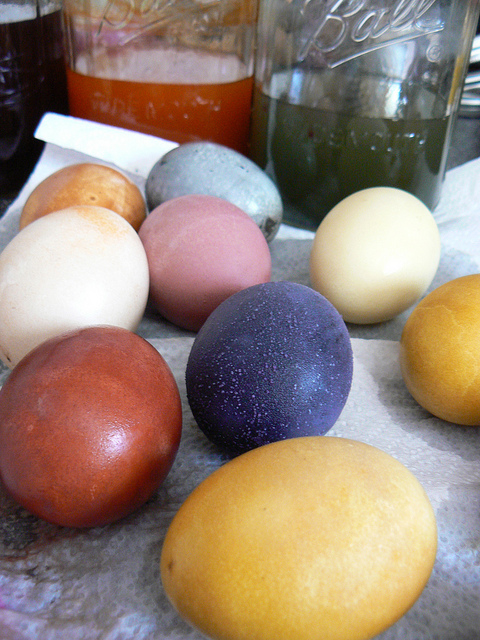
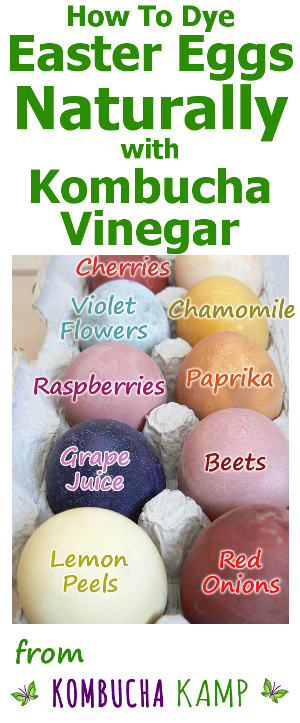 Spring is here! The Vernal Equinox – when the light of day and night are equally balanced – has shifted and the days are growing longer and brighter as we rush toward Summer.
Spring is here! The Vernal Equinox – when the light of day and night are equally balanced – has shifted and the days are growing longer and brighter as we rush toward Summer.
Since humans have had to live in harmony with nature, it is only natural that at this time of year every culture has a Spring celebration. From Easter to Passover to the Equinox, there are a multitude of ways to express the feeling of renewal and rebirth that this time of year brings.
As a child, my favorite part of the Easter celebration was coloring eggs with my brother and sister. We would gather around the table under Mom’s supervision and gleefully dunk hard boiled eggs into different cups of brightly colored dye (oh what we didn’t know about all the chemicals in those dyes then!).
Little did I realize as a child that this tradition of coloring eggs has been passed down through millennia.
Why Eggs at Easter?
Eggs have long been a symbol of fertility and rebirth. In ancient times, people would gather flowers or herbs in season to steep into natural dyes. These eggs were precious and nutritious gifts that were given to friends and loved ones and carried a lucky blessing.
After us kids had dyed the eggs, Easter eve, while still tucked in our beds, Mom and Dad would hide them around the yard. What a thrill to hunt through the yard – in the tomato bed, herb box or lilac bush – with basket in hand!
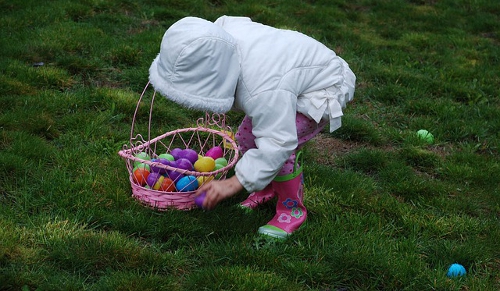
What great fun to espy a brightly colored egg nested among the newly emerging tulips! My instinctual competitive sibling rivalry impelled me to risk tearing my tights to find the most eggs. Of course, then came the obligatory week of egg salad sandwiches – sometimes the white part would retain some of the colors. Oh what fun!
So Why Hide Eggs at Easter?
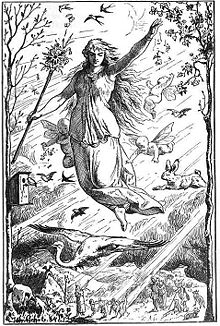
Ostara, the Goddess of Spring from Ancient Germany, is the likely namesake of Easter, though conclusive evidence is lacking.
Where did all this egg hiding come from? Like ring-around-the-rosy and other grim children’s rhymes or games, the origin of the Easter egg hunt hearkens back to a time when it wasn’t safe to participate in the ancient rituals of the “Old Religion.”
During the “Burning Times” when Christianity was on the rise, rather than give eggs as gifts and risk being persecuted, they were hidden in hedgerows and verdure.
In fact, the term “Easter” itself is purported to be derived from the old Germanic name of Ostara, the goddess of Spring.
The Catholic Church adopted the Spring Festival in 155 AD and named it Easter.
This Easter, ditch the chemical dyes and return to nature to color your eggs. Using Kombucha Vinegar to dye Easter eggs naturally gives the color more saturation power.
Spring Festivals
Spring Festivals are popular around the world. Here are just a few of them:
- Songkran Water Festival – Thailand, traditional new years day just after the spring equinox every year
- Las Fallas & Semana Santa (Holy Week) – Las Fallas is an ancient celebration in Spain that has been converted by Catholicism into a celebration for St. Joseph and takes place during Semana Santa with celebrations in Catholic countries like Mexico and Spain with parades, fireworks and ceremonies
- Holi & Holla Mohalla – festival in India where they throw brightly colored power at each other to symbolize the colors of Spring and celebrate Hindu and Sikh traditions
- Nowruz – Persian New Year celebrated on the Vernal Equinox
- Cooper’s Hill Cheese Rolling – centuries old tradition of chasing a wheel of cheese down a steep hill near Gloucester England
Dye Easter Eggs Naturally
with Kombucha Vinegar
Learning to dye Easter eggs naturally is a simple, safe and fun process for kids and kids at heart. The only ingredients you need are boiled eggs, Kombucha vinegar, and a colorful selection of foods (see list below). You will also want a number of ceramic or glass vessels for the eggs to soak in. Mason jars work wellas each jar can fit 2-4 eggs depending on the amount of dye liquid.
- To start place the natural dye base in a pot and cover with 2-3 cups water. Bring water up to a boil and then turn down to a simmer for the recommended time (anywhere from 10 minutes to an hour depending on the dye-source.)
- As the dye is simmering, gently wash boiled eggs in warm water with a gentle soap, rinse well and dry with a lint-free towel. Washing removes oily residues on the eggs and will help achieve a more uniform color.
- When dye reaches a hue you like, strain hot liquid into your jars or bowls, then add Kombucha vinegar (1 Tbsp per cup of dye).
- Carefully place washed eggs into hot dye with a wooden spoon. Soak until shells reach desired color. You can leave the eggs in the dye for up to 24 hours for maximum color. If you plan on eating your Easter eggs, put them into the refrigerator after the liquid has cooled.
Natural Dye Bases, Amounts, Cooking Times and Tips
When using natural dyes there aren’t necessarily set formulas; you may want to add more or less depending on the individual fruits, or flowers available. Following these general guidelines, though, should yield successful results to coloring your eggs.
- Use about 1-2 handfuls of chopped whole vegetables or fruits. Chopping bulky them will help them release their colors to the water quicker.
- Use about 1-2 Tablespoons of spices.
- Most dye sources can be simmered for 10-15 minutes or less but certain ingredients need to be be boiled for a longer period of time (marked with a B) to create an effective dye, typically 30 minutes to 1 hour. Add an extra cup or two of water at the beginning to make sure you have enough dye liquid.
- Use juices directly without adding extra water unless you are aiming for a lighter-colored dye.
- Some dyes, such as grape juice, may actually condense small particles of sediment on the eggs. The sediment will produce a darker color but may make for spotty colors if wiped off just before drying.
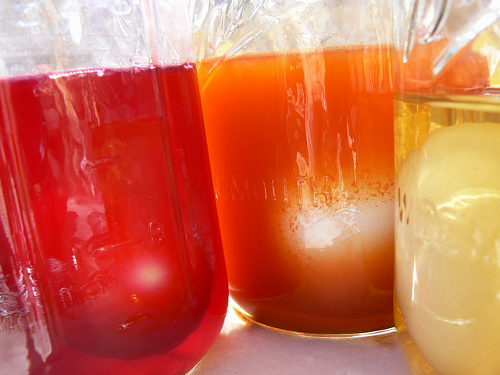
Lavender
Small Amount of Purple Grape Juice + water
Violet Flowers + 2 tsp Lemon Juice (THRIVE, AMZ)
Hibiscus (~10-15 min only)
Violet Blue
Violet Flowers (no lemon juice)
Red Onion Skins (AMZ) (B)
Red Wine (THRIVE, AMZ)
Blue
Canned Blueberries (AMZ)
Large Amount of Purple Grape Juice (AMZ) (~10 min)
Red Cabbage Leaves (B)
Green
Large Amount of Spinach Leaves (AMZ) (B ~1hr)
Fresh Basil (B)
Greenish Yellow
Yellow Delicious Apple Peels (B)
Fresh Parsley (AMZ) (B)
Yellow
Chamomile (~10-20 min)
Orange or Lemon Peels (B)
Celery Seed (THRIVE, AMZ) (B)
Ground Cumin (THRIVE, AMZ) (B)
Ground Turmeric (B)
Carrot Tops (B)
Golden Brown
Dill Seeds (AMZ)
Jasmine Green Tea (~10-15 min)
Brown
Strong or Instant Coffee (THRIVE, AMZ)
Black Walnut Shells (B)
Darjeeling Black Tea (~10 min)
Orange
Yellow Onion Skins (B)
Carrots (B ~1 hr)
Paprika (THRIVE, AMZ) (~10 min)
Chili Powder (THRIVE, AMZ)
Pink
Red Grape Juice
Fresh Cranberries / Cranberry Juice
Raspberries
Beets/Juice from jar of Pickled Beets (~10-15min)
Red
Lots of Red Onions Skins (B ~30-45min)
Canned Cherries with Juice
Pomegranate Juice
Raspberries
What are your favorite Easter traditions or memories? Share them in the comments below!
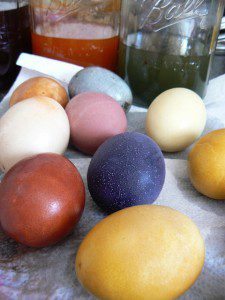
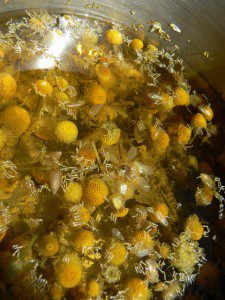
Hannah Crum
April 9, 2019 at 5:03 pmThis method has been a staple for years. Certainly the boiling water may be added to the individual dye jars as long as they are ready to receive water that hot and do not shatter (pour it in the sink)
Yes, soaking it longer will yield a deeper color.
Char
March 16, 2013 at 10:06 pmInstead of boiling some of the ingredients for longer, could one leave the eggs/dye ingredients in the jar for a longer period of time (as in several days)? Or is it the longer boiling time that releases more natural color? Last year I used a different blogger’s guide who recommended boiling a lot of water and then adding the boiling water to the jars with dye ingredients in it to save time/effort.
larry
July 4, 2012 at 9:10 amIam on my third batch so far so good thanks for your help
god bless larry